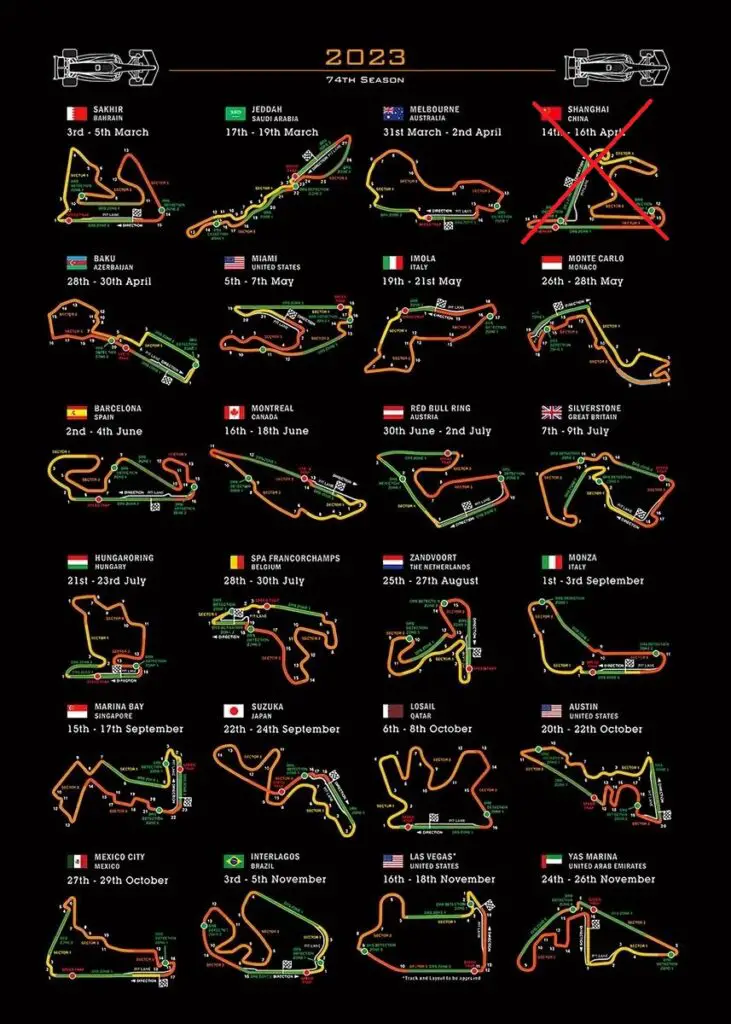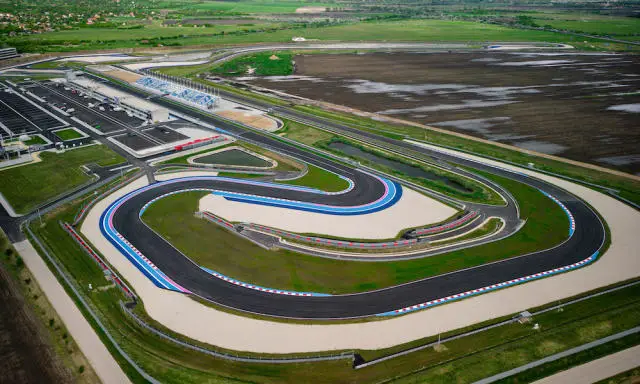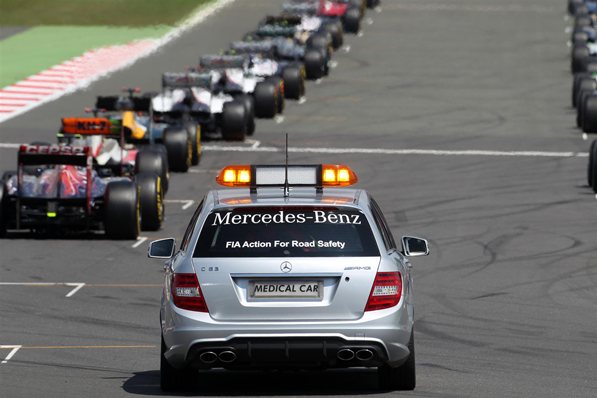Formula One (also known as an F1 Race) is the highest class of international racing for open-wheel single-seater formula racing cars. The Fédération Internationale de l’Automobile (FIA) sanction F1 and Liberty Media owns it.
Liberty is an American mass media company that through its wholly owned subsidiary, the Formula One Group owns F1.
F1 is one of the most popular and prestigious forms of motorsport in the world, attracting millions of fans and sponsors every year. But what goes into the organization of an F1 race?
This article, we will answer these questions and more, to give you an insight into the complex and fascinating process of organizing an F1 race.
How Does the FIA Select The Circuit?

The selection of the circuit for an F1 race is a long and complicated process that involves many factors, such as:
- The interest and demand from the local market and fans
- The availability and suitability of the existing or potential venues
- The financial viability and sustainability of the event
- The political and legal support and stability of the host country
- The safety and environmental standards and regulations of the FIA
- The logistical and operational challenges and opportunities of the location
- The strategic vision and objectives of the Formula One Group
The Formula One Group is responsible for negotiating and signing contracts with the promoters of each Grand Prix.
The promoters are usually representatives of the host country’s government, tourism board, or private investors. The contracts typically last for several years, with options for renewal or termination.
The Formula One Group also works closely with the FIA, which is the governing body of motorsport, to ensure that the circuits meet the technical and safety requirements for F1 racing.
How Does The Formula One Group Make Money?
The hosting fee is one of the main sources of revenue for the Formula One Group. It also earns money from
- Broadcasting rights
- Sponsorship deals
- Merchandise sales
- Hospitality packages
- Other commercial activities
The Formula One Group then distributes some of its profits to the teams, drivers, FIA, and other stakeholders.
How Much Does The Circuit Pay To Host An F1 Race?
The circuit pays a hosting fee to the Formula One Group to host a Grand Prix, which is usually a significant amount of money that covers part of the costs of running the event. The hosting fee varies depending on the market size, popularity, and bargaining power of each circuit.
According to Forbes, in 2019 the following amounts were paid.
| Country | An F1 Race Hosting Fee |
|---|---|
| Monaco | $30 million |
| Singapore | $60 million |
| Brazil | $65 million |
| China | $75 million |
| Canada | $80 million |
| Australia | $90 million |
| Mexico | $100 million |
| Bahrain | $110 million |
| Russia | $120 million |
| Azerbaijan | $140 million |
| Abu Dhabi | $150 million |
| Japan | $160 million |
| France | $170 million |
| Spain | $180 million |
| Italy | $200 million |
| Britain | $210 million |
| Belgium | $220 million |
| Germany | $230 million |
| Hungary | $240 million |
| USA | $250 million |
How Does The FIA Ensure The Circuit Is Equipped To Host An F1 Race?
The FIA checks that the circuit conforms to regulations by conducting inspections and audits before and during each Grand Prix.
It has a team of experts who are responsible for ensuring that the circuit meets the standards for safety, quality, design, layout, facilities, equipment, operations, personnel, emergency services, and environmental impact.
The FIA also monitors and enforces the rules and regulations for on-track activities such as practice sessions, qualifying sessions, and races.
The FIA grades each circuit based on its level of compliance with its requirements.
The grading is as follows.
Grade 1 F1 Race Circuits

Grade 1 is the highest rating of a circuit. These tracks are equipped to handle an F1 race. There are 41 Grade 1 circuits globally.
Street circuits cost less to initiate than those on purpose-built tracks since they don’t require construction of a new venue. Permanent circuits take years to build but street circuits can take little more than a year to prepare.
Although street circuits are cheaper to develop the annual running costs are substantially higher because the cost of transforming and maintaining the public roads to the required standard is higher.
For testing, besides a grade 1 racetrack with proper safety, the circuit requires various measures, including adequate run-off areas, barriers built to FIA specification, debris fences – in three tiers in places and two around the entire circuit.
Grade 2 F1 Race Circuits
There are 62 circuits that meet the grade 2 standards.
These circuits may host events involving “Automobiles of Groups D and E (Free formula) with a weight/power ratio of between 1 and 2 kg/horsepower.
Teams may test at Grade 2 circuits.
Grade 3 Circuits
There are 38 grade 3 circuits around the world.
Grade 3 circuits can host events involving “Category II Automobiles with a weight/power ratio of between 2 and 3 kg/horsepower.
In 2020 the FIA gave a specific grade for a Formula E circuit. “Grade 3E” is the designation.
Grade 4 Circuits
There are 9 grade 4 circuits across the globe.
Grade Four circuits can host events involving “Category I Automobiles. Category II Automobiles with a weight/power ratio higher than 3 kg/horsepower.
Grade 5 Circuits
Grade 5 used to be the designation for events with alternative energy vehicles. In September 2022 when the rating was changed to designate developing circuits with FIA Provisional Circuit Licenses.
Grade 6 Circuits
There are 16 Grade Six circuits.
Grade Six is split into three parts:
- Grade 6A for all classes of Autocross vehicles
- Grade 6R for all classes of Rallycross vehicles
- Grade 6G for all classes of Ice Racing vehicles.
The FIA can upgrade or downgrade a circuit’s grade depending on its performance or changes.
How Are The F1 Race Marshals Appointed?
The marshals are appointed by the national motorsport authority of each host country. The countries have a pool of qualified and experienced volunteers who have undergone training and certification by the FIA.
The national motorsport authority selects and assigns the marshals for each Grand Prix based on their availability, skills, preferences, and performance.
The FIA also appoints some international marshals who have special expertise or experience in certain areas, such as firefighting, medical intervention, or race stewarding.
The number of marshals required for each Grand Prix depends on the size, layout, and complexity of the circuit, but it can range from hundreds to thousands.
The number so marshals required are extensive. A sample of the 2019 marshal numbers is listed below.
- Monaco had 650 marshals.
- Russia had 2,200 marshals.
- Azerbaijan had 2,400 marshals.
- Spain had 3,200 marshals.
- Britain had 3,600 marshals.
- USA had 4,400 marshals.
Are The F1 Race Marshals Paid?

The marshals are not paid by the FIA or the Formula One Group. They are usually volunteers who are passionate about motorsport and want to contribute to the success of the event.
Marshals are recruited, trained, and supervised by the national motorsport authority of each host country, which is affiliated with the FIA.
The marshals are responsible for ensuring the safety and smooth running of the on-track activities, such as:
- Displaying flags and signals to communicate with the drivers and officials
- Assisting with the recovery and removal of crashed or stranded cars
- Dealing with incidents such as fires, oil spills, debris, or animals on the track
- Reporting any problems or violations to the race control
- Providing first aid or medical assistance if needed
The marshals are usually provided with uniforms, equipment, food, drinks, transportation, and accommodation by the promoters of each Grand Prix. They may also receive some perks such as tickets, souvenirs, access to the paddock, or meeting the drivers or celebrities.
Who Provides The F1 Race Infrastructure?
The host circuit provides the infrastructure. If the racetrack is a permanent venue most of the infrastructure will be incorporated on a permanent basis.
If the race format is a street circuit, there are substantial costs to set up the circuit for each event. These include the following.
The Grandstands
In a street circuit sufficient grandstand capacity must be erected to cope with the expected number of fans.
Costs are upward of $100,000 perr event.
F1 Race Safety Barriers
The FIA has a very strict safety protocol and safety barriers have to be erected as directed by them.
Safety barriers and fencing costs upwards of $10 million per event.
Who Erects The Pit Area?
The pit area is erected by a team of contractors hired by the promoters of each Grand Prix.
The pit area consists of several structures and facilities.
- The pit lane: a section of the track where the cars enter and exit the pit area
- The pit wall: a barrier that separates the pit lane from the track
- The pit boxes: individual garages where each team sets up their equipment and works on their cars
- The pit building: a multi-storey structure that houses offices, hospitality suites, media centers, and other amenities for the teams and guests
- The pit gantry: a bridge that spans over the pit lane and displays information such as lap times and positions
The team of contractors is responsible for designing, building, transporting, installing, operating, and dismantling the pit area according to the specifications set by the FIA and the Formula One Group.
The contractors also work closely with the circuit staff and officials to ensure that the pit area is safe, functional, and compliant.
F1 Race Insurance
Insurance is required to cover the following events.
- The circuits liability should any third party be injured or killed.
- Cancellation insurance to cover the organizers costs of the event is cancelled, as happened in Imola in 2023.
- Material damage cover for all of the infrastructure, vehicles, offices etc.
The insurance cost for a 4-day event is upwards of $1,200,000.
Who Is Responsible For Emergency Medical Services?

The FIA provide a medical car that starts the back of the grid and is the held on standby for any emergencies during the race. The balance of the emergency medical services are provided by a team of professionals hired by the promoters of each Grand Prix.
The emergency medical services consist of several elements that are vital for ensuring the health and safety of everyone involved in the event. These include:
The Medical Center
This is a fully equipped clinic located near the pit area that can handle any medical emergencies or injuries that may occur during the event..
The Medical Evac Helicopter
A specially equipped helicopter that can transport any seriously injured person from the circuit to a nearby hospital.
The Medical And First Aid Staff
A group of doctors, nurses, paramedics, and other specialists who have extensive experience and training in motorsport medicine is provided on site.
The team of professionals is responsible for planning, coordinating, and delivering the emergency medical services according to the standards and guidelines of the FIA and the Formula One Group.
Who Is Responsible For Marketing The Event
Although the Formula One team do market, the main activity is carried out by the host circuit. Marketing costs of $10 million per event are quite normal.
Conclusion
Hosting an F1 race requires a financial commitment that is measured in many millions of dollars. The benefit of increased tourism and marketing of the country help to offset the costs, and ins ome cases produce a profit.
Other Articles You May Find Of Interest
- Who Owns Formula 1 – The Fascinating Truth (f1worldwide.com)
- How Much Money Does F1 Make? (f1worldwide.com)
- How F1 Teams Make Money -Behind Closed Door (f1worldwide.com)
- How Much o F1 Drivers Make? (f1worldwide.com)
- Formula 1 Car Costs in 2023 (f1worldwide.com)
- F1 viewership – How Many People Watch F1? (f1worldwide.com)

